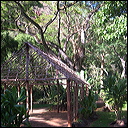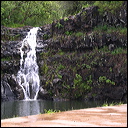
|
Waimea Valley: 1000 years of History Provided by the Office of Hawaiian Affairs Waimea Valley is a cultural resource of the highest possible magnitude, according to the diverse group of cultural practitioners, planners, archeologists, botanists and others who have studied the area. While the landscape has been used, modified and exploited, Waimea Valley remains one of the last undeveloped areas on the island of O‘ahu, and today continued support for the valley’s preservation runs strong. As the timeline below illustrates, Waimea Valley is filled with a sacred spirit and a remarkable history, well worth the continued work of preservation. Waimea Valley Timeline Beginning late 11th century: Waimea Valley is established as an important ahupua‘a, a mountain to sea land division containing necessary natural resources to sustain a substantial number of residents. Beginning late 11th century: O‘ahu ruler Kamapua‘a gives control of the valley to the Pa‘ao line of kahuna nui – high priests – to serve as their spiritual headquarters. For the next 700 years, the valley is passed down through the Pa‘ao line as a sacred “Valley of the Priests.” Middle 1700s: O‘ahu ruler Kahahana constructs two main heiau, or sacred temples, partly with the intent of furthering spiritual communication with the great chief Kekaulike of Kaua‘i. Late 1700’s: After conquest of O‘ahu, Kamehameha I awards acknowledges the importance of Waimea Valley by placing its control in the hands of top his spiritual advisor Hewahewa, also the last kahuna nui in the Pa‘ao line. 1848: Nearly eight centuries of kahuna stewarship ends with the Mahele land division. Private ownership first goes to grand-daughter of Hewahewa. 1894 to 1898: Series of floods devastate the valley including homes and crops of approximately 1,000 Native Hawaiians. 1929: Castle & Cook pineapple and sugar company completes purchase of Waimea and leases land to cattle ranchers 1940s: After attack on Pearl Harbor, U.S. military establishes temporary installations in the valley. 1970s through mid 1990s: Bishop Corporation (no affiliation with Bishop Estate) purchases Waimea for $355,000 and establishes Waimea Falls Park. For a 25-year period under the ownership of the Pietsch family, the valley is a commercial park with a restaurant and entertainment. A 150-acre arboretum and botanical garden is also established with native and endangered Hawaiian plants, as well as exotic species. During period of peak commercial success, park attendance averages 2,000 per day. Early 1990s: Commercial viability of Waimea Falls Park falters. 1996 through 2000: New York investor and theme-park developer Christian Wolffer assumes previous owner’s mortgage and develops an “adventure park,” but park attendance is in decline. Investor Wolffer puts valley up for sale at $25 million, later reduced to $19 million. 2000: Hawai‘i residents form Stewards of Waimea Valley to promote valley preservation and prevent further development. Overall community opposition to Waimea Valley development gains momentum. Honolulu City Council passes a resolution, requesting Mayor to move forward on acquiring the park. 2001: Investor Wolffer places the valley under bankruptcy protection. A New York Bankruptcy court gives City & County of Honolulu permission to proceed with condemnation process in order to purchase the property. 2002 to 2003: The City & County of Honolulu takes possession of the property through condemnation and awards a lease to the National Audubon Society, which begins management of an ecological and cultural visitor center at Waimea Valley. November 2005: Wolffer makes an offer in the condemnation action and offers to settle with the City & County of Honolulu by dividing the ownership of the valley under a plan that would enable his establishment of a commercial attractions park and residential subdivision. City Council gives preliminary approval to the deal. December 2005: Wolffer’s disclosure of plan to add luxury housing to Waimea Valley parcels sparks public opposition. OHA joins with other city, state, federal and private agencies to consider a plan for purchasing Waimea Valley with pooled resources. 2006: Under terms of a court settlement, the valley is purchased by a partnership of OHA, the City & County of Honolulu, the State Department of Land and Natural Resources, the U.S. Army and the National Audubon Society, with the title passing to OHA for the purpose of ensuring the preservation of Waimea Valley. 2007: OHA takes steps to assume responsibility for operations at Waimea Valley from leaseholder Audubon Society by filing papers to form a limited liability corporation, named Hi‘ilei Aloha. The intent is to create a subsidiary non-profit corporation to preserve Waimea Valley and enhance day-to-day operations. |
|||||||||||||||





